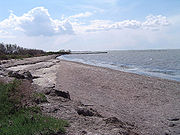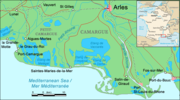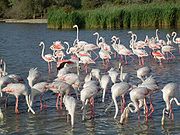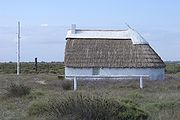
Camargue
Encyclopedia

The Camargue is the region located south of Arles
Arles
Arles is a city and commune in the south of France, in the Bouches-du-Rhône department, of which it is a subprefecture, in the former province of Provence....
, France
France
The French Republic , The French Republic , The French Republic , (commonly known as France , is a unitary semi-presidential republic in Western Europe with several overseas territories and islands located on other continents and in the Indian, Pacific, and Atlantic oceans. Metropolitan France...
, between the Mediterranean Sea
Mediterranean Sea
The Mediterranean Sea is a sea connected to the Atlantic Ocean surrounded by the Mediterranean region and almost completely enclosed by land: on the north by Anatolia and Europe, on the south by North Africa, and on the east by the Levant...
and the two arms of the Rhône River
Rhône
Rhone can refer to:* Rhone, one of the major rivers of Europe, running through Switzerland and France* Rhône Glacier, the source of the Rhone River and one of the primary contributors to Lake Geneva in the far eastern end of the canton of Valais in Switzerland...
delta
River delta
A delta is a landform that is formed at the mouth of a river where that river flows into an ocean, sea, estuary, lake, reservoir, flat arid area, or another river. Deltas are formed from the deposition of the sediment carried by the river as the flow leaves the mouth of the river...
. The eastern arm is called the Grand Rhône; the western one is the Petit Rhône.
Administratively it lies within the département of Bouches-du-Rhône
Bouches-du-Rhône
Bouches-du-Rhône is a department in the south of France named after the mouth of the Rhône River. It is the most populous department of the Provence-Alpes-Côte d'Azur region. Its INSEE and postal code is 13.-History of the department:...
, the appropriately named "Mouths of the Rhône", and covers parts of the territory of the communes
Communes of France
The commune is the lowest level of administrative division in the French Republic. French communes are roughly equivalent to incorporated municipalities or villages in the United States or Gemeinden in Germany...
of Arles - the largest commune in Metropolitan France
Metropolitan France
Metropolitan France is the part of France located in Europe. It can also be described as mainland France or as the French mainland and the island of Corsica...
, Saintes-Maries-de-la-Mer
Saintes-Maries-de-la-Mer
Saintes-Maries-de-la-Mer is the capital of the Camargue in the south of France. It is a commune in the Bouches-du-Rhône department by the Mediterranean Sea. Population: 2,478...
- the second largest - and Port-Saint-Louis-du-Rhône
Port-Saint-Louis-du-Rhône
Port-Saint-Louis-du-Rhône is a commune in the Bouches-du-Rhône department in southern France.-History:The commune was created in 1904 from Arles and Fos-sur-Mer on which its history is dependent. The Saint-Louis channel was dug in 1871...
. A further expanse of marshy plain, the Petite Camargue (little Camargue), just to the west of the Petit Rhône, is in the département of Gard
Gard
Gard is a département located in southern France in the Languedoc-Roussillon region.The department is named after the River Gard, although the formerly Occitan name of the River Gard, Gardon, has been replacing the traditional French name in recent decades, even among French speakers.- History...
.
Camargue was designated a Ramsar site as a "Wetland
Wetland
A wetland is an area of land whose soil is saturated with water either permanently or seasonally. Wetlands are categorised by their characteristic vegetation, which is adapted to these unique soil conditions....
of International Importance" on December 1, 1986. The area was also the inspiration for naming Operation Camargue
Operation Camargue
Operation Camargue was one of the largest operations by the French Far East Expeditionary Corps and Vietnamese National Army in the First Indochina War. It took place from 28 July until 10 August 1953...
during the First Indochina War
First Indochina War
The First Indochina War was fought in French Indochina from December 19, 1946, until August 1, 1954, between the French Union's French Far East...
.
Geography

Brine
Brine is water, saturated or nearly saturated with salt .Brine is used to preserve vegetables, fruit, fish, and meat, in a process known as brining . Brine is also commonly used to age Halloumi and Feta cheeses, or for pickling foodstuffs, as a means of preserving them...
lagoon
Lagoon
A lagoon is a body of shallow sea water or brackish water separated from the sea by some form of barrier. The EU's habitat directive defines lagoons as "expanses of shallow coastal salt water, of varying salinity or water volume, wholly or partially separated from the sea by sand banks or shingle,...
s or étangs, cut off from the sea by sandbars and encircled by reed
Phragmites
Phragmites, the Common reed, is a large perennial grass found in wetlands throughout temperate and tropical regions of the world. Phragmites australis is sometimes regarded as the sole species of the genus Phragmites, though some botanists divide Phragmites australis into three or four species...
-covered marshes. These are in turn surrounded by a large cultivated area.
Approximately a third of the Camargue is either lakes or marshland. The central area around the shoreline of the Étang de Vaccarès
Étang de Vaccarès
Étang de Vaccarès is a lake, or rather; a salt water lagoon , in the wetlands of the Camargue in the delta of the River Rhône in southern France.- Description:The lake has an area of 65 km², and the depth is less than two meters...
has been protected as a regional park
Regional park
Regional park is a term used for an area of land preserved on account of its natural beauty, historic interest, recreational use or other reason, and under the administration of a form of local government.-Definition:...
since 1927, in recognition of its great importance as a haven for wild birds. In 2008 it was incorporated into the larger Parc naturel régional de Camargue.
Flora and fauna

Greater Flamingo
The Greater Flamingo is the most widespread species of the flamingo family. It is found in parts of Africa, southern Asia , and southern Europe...
. The marshes are also a prime habitat for many species of insects, notably (and notoriously) some of the most ferocious mosquito
Mosquito
Mosquitoes are members of a family of nematocerid flies: the Culicidae . The word Mosquito is from the Spanish and Portuguese for little fly...
s to be found anywhere in France. It is also famous for the Camargue Bull
Camargue cattle
The Camargue cattle breed, in Provençal: Raço di bioù, is native to the Camargue marshlands of the delta of the River Rhone in southern France. The cattle are black in color with upward sweeping horns...
and the Camargue Horse
Camargue (horse)
The Camargue horse is an ancient breed of horse indigenous to the Camargue area in southern France. For centuries, possibly thousands of years, these small horses have lived wild in the harsh environment of the Camargue marshes and wetlands of the Rhone delta. There they developed the stamina,...
.
The flora of the Camargue is specially adapted to cope with the saline conditions. Sea lavender and glasswort
Glasswort
Salicornia is a genus of succulent, halophyte plants that grow in salt marshes, on beaches, and among mangroves. Salicornia species are native to North America, Europe, South Africa, and South Asia...
flourish, along with tamarisks and reeds.
Regional park
Officially established as a regional park and nature reserve in 1970, the Parc Naturel Régional de Camargue covers 820 km² that are some of the wildest and most protected in all of Europe. A roadside museum provides background on flora, fauna, and the history of the area.Human influence
Humans have lived in the Camargue for millennia, greatly affecting it with drainage schemes, dykesLevee
A levee, levée, dike , embankment, floodbank or stopbank is an elongated naturally occurring ridge or artificially constructed fill or wall, which regulates water levels...
, rice
Rice
Rice is the seed of the monocot plants Oryza sativa or Oryza glaberrima . As a cereal grain, it is the most important staple food for a large part of the world's human population, especially in East Asia, Southeast Asia, South Asia, the Middle East, and the West Indies...
paddies and salt pans
Salt evaporation pond
Salt evaporation ponds, also called salterns or salt pans, are shallow artificial ponds designed to produce salts from sea water or other brines. The seawater or brine is fed into large ponds and water is drawn out through natural evaporation which allows the salt to be subsequently harvested...
. Much of the outer Camargue has been drained for agricultural purposes. The Camargue has its own eponymous horse breed
Camargue (horse)
The Camargue horse is an ancient breed of horse indigenous to the Camargue area in southern France. For centuries, possibly thousands of years, these small horses have lived wild in the harsh environment of the Camargue marshes and wetlands of the Rhone delta. There they developed the stamina,...
, the famous white Camarguais ridden by the gardians, who rear the region's fighting bulls
Bullfighting
Bullfighting is a traditional spectacle of Spain, Portugal, southern France and some Latin American countries , in which one or more bulls are baited in a bullring for sport and entertainment...
for export to Spain
Spain
Spain , officially the Kingdom of Spain languages]] under the European Charter for Regional or Minority Languages. In each of these, Spain's official name is as follows:;;;;;;), is a country and member state of the European Union located in southwestern Europe on the Iberian Peninsula...
, as well as sheep. Many of these animals are raised in semi-feral
Semi-feral
A semi-feral animal is an animal that lives predominantly in a feral state, but has some contact and experience with humans. This may be due to having been born into a domesticated state and then reverting to life in wild conditions, or it may be an animal that grows up in essentially wild...
conditions within a Manade
Manade
A manade is a term used mainly in the Camargue area in France for a semi-feral group of Camargue cattle or horses led by a gardian, or herder. In French, the word manade dates from 1867...
.

Arles
Arles is a city and commune in the south of France, in the Bouches-du-Rhône department, of which it is a subprefecture, in the former province of Provence....
, located at the extreme north of the delta where the Rhône forks into its two principal branches. The only other towns of note are Saintes-Maries-de-la-Mer
Saintes-Maries-de-la-Mer
Saintes-Maries-de-la-Mer is the capital of the Camargue in the south of France. It is a commune in the Bouches-du-Rhône department by the Mediterranean Sea. Population: 2,478...
, about 45 km to the southwest and the medieval fortress-town of Aigues-Mortes
Aigues-Mortes
Aigues-Mortes is a commune in the Gard department in southern France.The medieval city walls surrounding the city are well preserved.-History:...
on the far western edge, in the Petite Camargue. Saintes-Maries-de-la-Mer is the destination of the annual Roma pilgrimage for the veneration of Saint Sarah
Saint Sarah
Saint Sarah, also known as Sara-la-Kali , is the mythic patron saint of the Roma people. The center of her veneration is Saintes-Maries-de-la-Mer, a place of pilgrimage for Roma in the Camargue, in southern France...
.
The Camargue was exploited in the Middle-Ages by Cistercian and Benedictine
Benedictine
Benedictine refers to the spirituality and consecrated life in accordance with the Rule of St Benedict, written by Benedict of Nursia in the sixth century for the cenobitic communities he founded in central Italy. The most notable of these is Monte Cassino, the first monastery founded by Benedict...
monks. In the 16-17th centuries, big estates, known locally as mas
Mas (Provencal Farmhouse)
A mas is a traditional farmhouse in the Provence region of France as well as in Catalonia, where is also named masia or masía ....
, were founded by rich landlords from Arles. At the end of the 18th century, the Rhône was diked up. In 1858, the building of the digue à la mer (dyke to the sea) achieved protection of the delta from erosion.
The north of the Camargue is made of agricultural land. The main crops are cereals, grapevine and rice. Near the seashore, prehistoric man started extracting salt, a practice that continued. This was a source of wealth for the Cistercian "salt abbeys" of Ulmet
Ulmet
Ulmet may refer to several villages in Romania:* Ulmet, a village in Bozioru Commune, Buzău County* Ulmet, a village in Stoina Commune, Gorj County* Ulmet, a village in Dobrun Commune, Olt Countyand to:...
, Franquevaux and Psalmody in the Middle Ages. The salt industry started in the 19th century, and big chemical companies such as Péchiney and Solvay, founded the 'mining' city of Salin-de-Giraud.
The boundaries of the Camargue are constantly revised by the Rhône as it transports huge quantities of mud downstream - as much as 20 million m³ annually. Some of the étangs are in fact the remnants of old arms and legs of the river. The general trend is for the coastline to move outwards. Aigues-Mortes
Aigues-Mortes
Aigues-Mortes is a commune in the Gard department in southern France.The medieval city walls surrounding the city are well preserved.-History:...
, originally built as a port on the coast, is now some 5 km (3.1 mi) inland. The pace of change has been modified somewhat in recent years by man-made barriers, such as dam
Dam
A dam is a barrier that impounds water or underground streams. Dams generally serve the primary purpose of retaining water, while other structures such as floodgates or levees are used to manage or prevent water flow into specific land regions. Hydropower and pumped-storage hydroelectricity are...
s on the Rhône and sea dykes, but flooding remains a problem across the region.
Film portrayal
- The 1953 children's film Crin-BlancWhite ManeWhite Mane is a 1953 short film directed by award-winning French filmmaker Albert Lamorisse....
, known in English as White Mane, portrays the horses and region. Directed by Albert Lamorisse, the black-and-white film won the Prix Jean VigoPrix Jean VigoThe Prix Jean Vigo is an award in the Cinema of France given annually since 1951 to a French film director in homage to Jean Vigo. It was founded by French writer Claude...
award and the Cannes Film FestivalCannes Film FestivalThe Cannes International Film Festival , is an annual film festival held in Cannes, France, which previews new films of all genres including documentaries from around the world. Founded in 1946, it is among the world's most prestigious and publicized film festivals...
's Grand Prize, both for short film.
- The majority of the youthful romance movie Friends (1971)Friends (1971 film)Friends is a 1971 film directed by Lewis Gilbert and written by Gilbert, Vernon Harris and Jack Russell. The soundtrack by Elton John and Bernie Taupin was released as the Friends album. The film was nominated for Golden Globe Award for Best English-Language Foreign Film at the 1972 Golden Globe...
takes place in the Camargue, with numerous scenes of wetlands and wildlife. "Michelle's Song," from the soundtrackFriends (soundtrack)Friends is a project Elton John and Bernie Taupin took on before their breakout success in the United States. Recorded as the soundtrack to the film Friends, it was certified gold on its release on April 6, 1971 in the U.S...
by Bernie TaupinBernie TaupinBernard John "Bernie" Taupin is an English lyricist, poet, and singer, best known for his long-term collaboration with Elton John, writing the lyrics for the majority of the star's songs, making his lyrics some of the best known in pop-rock's history.In 1967, Taupin answered an advertisement in...
and Elton JohnElton JohnSir Elton Hercules John, CBE, Hon DMus is an English rock singer-songwriter, composer, pianist and occasional actor...
, includes the phrase "tiny daughter of the Camargue."
- The 1963 Hammer Films thriller The Maniac was partly filmed in Camargue.
See also
- Bac du Sauvage
- Folco de Baroncelli-JavonFolco de Baroncelli-JavonFolco de Baroncelli-Javon , was a French writer and cattle farmer. As an influential gardian , he is an important figure in the traditional lifestyle and culture of the Camargue region of southern France.-Family and childhood:Though born in Aix-en-Provence, Falco de Baroncelli-Javon was baptised...
- Camargue red riceCamargue red riceCamargue red rice is a relatively new variety of rice cultivated in the wetlands of the Camargue region of southern France. It is a short-grained and unmilled variety of rice and is therefore quite sticky. It is a brownish-red colour. It has an intense somewhat nutty taste and a naturally chewy...
- Camargue horse
- Camargue equitationCamargue equitationCamargue Equitation is the traditional style of working riding of the gardian herders of the Camargue region of southern France. It is closely associated with the Camargue horse, with Camargue cattle, and with the bouvino, the traditional cultural world of cattle-farming in the Camargue....
- GardianGardianA gardian is a mounted cattle herdsman in the Camargue delta in Provence, southern France. The work is akin to that of the charro or cowboy....
- ManadeManadeA manade is a term used mainly in the Camargue area in France for a semi-feral group of Camargue cattle or horses led by a gardian, or herder. In French, the word manade dates from 1867...
External links
- Nacioun Gardians (Cultural association, Camargue, France)
- The Camargue at armchairfrance.com
- Parc naturel de Camargue (in French, English and Italian)
- Tourism Office of Saintes-Maries de la Mer
- Tourism Office of Arles
- Camargue Photogallery
- IMDB Crin-Blanc

